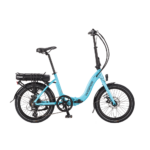OK my latest brain convulsion for the Tonaro after reading around is to parallel a new £208 Kudos 36V 10AH LiFePO4 batt with my Li-ion 10AH with a 30A 60V dual Schottky diode from Maplins 30a-schottky to prevent reverse charging. This would theoretically give me 20Ah in toto and so a 25A draw would not be harmful as presumably each batt would stay below 20A draw. So I get increased range & torgue without over-stressing either batt?
Now the diode would heat up I believe so can I bolt a bit of Alu straight onto the diode using the hole in the body of the diode, as it's epoxy.
Seems cheaper than going 48V, I can use up the stock Li-ion, I buy British (sort of), keep the stock controller (maybe) and there's a warranty with the Kudos batt. Connect either by Kudos batt connector or dismantle and fit some other waterproof connector - what? That may invalidate any warranty tho'.
The only other prob I can foresee is that the Li-ion would drop Voltage quicker and then more current be drawn from the LiFePO4. But if I limit DOD to 80% I should keep it reasonably equal at 10-15A each. Occasionally check performance of Li-ion as it ages too.
Charge each separately.
Who's going to burst my bubble?!
Also - What about some kind of attachable cooling vanes on the motor? Are there such things? I want to be able to crawl up steep, long off road hills at 36V X 25A.
Now the diode would heat up I believe so can I bolt a bit of Alu straight onto the diode using the hole in the body of the diode, as it's epoxy.
Seems cheaper than going 48V, I can use up the stock Li-ion, I buy British (sort of), keep the stock controller (maybe) and there's a warranty with the Kudos batt. Connect either by Kudos batt connector or dismantle and fit some other waterproof connector - what? That may invalidate any warranty tho'.
The only other prob I can foresee is that the Li-ion would drop Voltage quicker and then more current be drawn from the LiFePO4. But if I limit DOD to 80% I should keep it reasonably equal at 10-15A each. Occasionally check performance of Li-ion as it ages too.
Charge each separately.
Who's going to burst my bubble?!
Also - What about some kind of attachable cooling vanes on the motor? Are there such things? I want to be able to crawl up steep, long off road hills at 36V X 25A.






